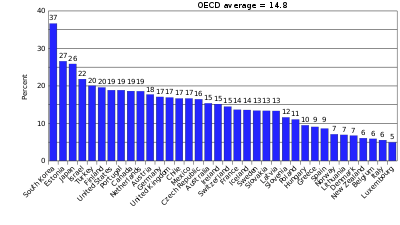Discrimination
Discrimination is the act of making an unfavourable distinction for a being based on the group, class, or category to which they are perceived to belong. Discrimination can be justified or prejudicial. Serious criminals may be discriminated against by sending them to jail while other groups may be unjustly discriminated against through bias and prejudice. People may discriminate on age, caste, criminal record, height, disability, family status, gender identity, gender expression, generation, genetic characteristics, marital status, nationality, color, race and ethnicity, religion, sex and sex characteristics, sexual orientation, social class, species, as well as other categories. Discrimination consists of treatment of an individual or group, based on their actual or perceived membership in a certain group or social category, "in a way that is worse than the way people are usually treated".[1] It involves the group's initial reaction or interaction going on to influence the individual's actual behavior towards the group leader or the group, restricting members of one group from opportunities or privileges that are available to another group, leading to the exclusion of the individual or entities based on illogical or irrational decision making.[2]
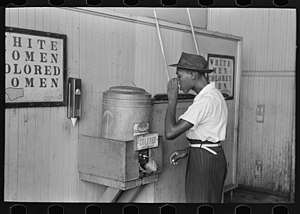
| Part of a series on |
| Discrimination |
|---|
|
General forms
|
| Specific forms |
|
Social
|
|
Religious
|
|
Ethnic/National
|
|
Manifestations
|
|
Policies
|
|
Countermeasures
|
|
Related topics
|
Discriminatory traditions, policies, ideas, practices and laws exist in many countries and institutions in every part of the world, including in territories where discrimination is generally looked down upon. In some places, controversial attempts such as quotas have been used to benefit those who are believed to be current or past victims of discrimination—but they have sometimes been called reverse discrimination.
Etymology
The term discriminate appeared in the early 17th century in the English language. It is from the Latin discriminat- 'distinguished between', from the verb discriminare, from discrimen 'distinction', from the verb discernere.[3] Since the American Civil War the term "discrimination" generally evolved in American English usage as an understanding of prejudicial treatment of an individual based solely on their race, later generalized as membership in a certain socially undesirable group or social category.[4] The word "discrimination" derives from Latin, where the verb discrimire means "to separate, to distinguish, to make a distinction".
Definitions
Moral philosophers have defined discrimination as disadvantageous treatment or consideration. This is a comparative definition. An individual need not be actually harmed in order to be discriminated against. They just need to be treated worse than others for some arbitrary reason. If someone decides to donate to help orphan children, but decides to donate less, say, to black children out of a racist attitude, then they would be acting in a discriminatory way despite the fact that the people they discriminate against actually benefit by receiving a donation.[5][6] In addition to this discrimination develops into a source of oppression. It is similar to the action of recognizing someone as 'different' so much that they are treated inhumanly and degraded.[7]
Based on realistic-conflict theory[8] and social-identity theory,[9] Rubin and Hewstone[10] have highlighted a distinction among three types of discrimination:
- Realistic competition is driven by self-interest and is aimed at obtaining material resources (e.g., food, territory, customers) for the in-group (e.g., favouring an in-group in order to obtain more resources for its members, including the self).
- Social competition is driven by the need for self-esteem and is aimed at achieving a positive social status for the in-group relative to comparable out-groups (e.g., favouring an in-group in order to make it better than an out-group).
- Consensual discrimination is driven by the need for accuracy and reflects stable and legitimate inter group status hierarchies (e.g., favouring a high-status in-group because it is high status).
The United Nations stance on discrimination includes the statement: "Discriminatory behaviors take many forms, but they all involve some form of exclusion or rejection."[11] International bodies United Nations Human Rights Council work towards helping ending discrimination around the world.
Types
Age
Ageism or age discrimination is discrimination and stereotyping based on the grounds of someone's age.[12] It is a set of beliefs, norms, and values which used to justify discrimination or subordination based on a person's age.[13] Ageism is most often directed towards old people, or adolescents and children.[14][15]
Age discrimination in hiring has been shown to exist in the United States. Joanna Lahey, professor at The Bush School of Government and Public Service at Texas A&M, found that firms are more than 40% more likely to interview a young adult job applicant than an older job applicant.[16] In Europe, Stijn Baert, Jennifer Norga, Yannick Thuy and Marieke Van Hecke, researchers at Ghent University, measured comparable ratios in Belgium. They found that age discrimination is heterogeneous by the activity older candidates undertook during their additional post-educational years. In Belgium, they are only discriminated if they have more years of inactivity or irrelevant employment.[17]
In a survey for the University of Kent, England, 29% of respondents stated that they had suffered from age discrimination. This is a higher proportion than for gender or racial discrimination. Dominic Abrams, social psychology professor at the university, concluded that ageism is the most pervasive form of prejudice experienced in the UK population.[18]
Caste
According to UNICEF and Human Rights Watch, caste discrimination affects an estimated 250 million people worldwide.[19][20][21] Discrimination based on caste, as perceived by UNICEF, is mainly prevalent in parts of Asia, (India, Sri Lanka, Bangladesh, China, Pakistan, Nepal, Japan), Africa and others.[19] As of 2011, there were 200 million Dalits or Scheduled Castes (formerly known as "untouchables") in India.[22]
Culture or subculture
Discrimination can be directed towards persons based on their cultures or subcultures. In 2013, the Greater Manchester Police in the United Kingdom began to classify attacks on subcultures such as goths, emos, punks and metallers as hate crimes, in the same way it records abuses against people because of their religion, race, disability, sexual orientation or transgender identity.[23] The decision followed the murder of Sophie Lancaster and beating of her boyfriend in 2007, who were attacked because they were goths.[24]
Disability
Discrimination against people with disabilities in favor of people who are not is called ableism or disablism. Disability discrimination, which treats non-disabled individuals as the standard of 'normal living', results in public and private places and services, educational settings, and social services that are built to serve 'standard' people, thereby excluding those with various disabilities. Studies have shown that disabled people not only need employment in order to be provided with the opportunity to earn a living but they also need employment in order to sustain their mental health and well-being. Work fulfils a number of basic needs for an individual such as collective purpose, social contact, status, and activity.[25] A person with a disability is often found to be socially isolated and work is one way to reduce his or her isolation.
In the United States, the Americans with Disabilities Act mandates the provision of equality of access to both buildings and services and is paralleled by similar acts in other countries, such as the Equality Act 2010 in the UK.
Language
Diversity of language is protected and respected by most nations who value cultural diversity. However, people are sometimes subjected to different treatment because their preferred language is associated with a particular group, class or category. Notable examples are the Anti-French sentiment in the United States as well as the Anti-Quebec sentiment in Canada targeting people who speak the French language. Commonly, the preferred language is just another attribute of separate ethnic groups. Discrimination exists if there is prejudicial treatment against a person or a group of people who either do or do not speak a particular language or languages. An example of this is when thousands of Wayúu Native Colombians were given derisive names and the same birth date, by government officials, during a campaign to provide them with identification cards. The issue was not discovered until many years later.[26]
Another noteworthy example of linguistic discrimination is the backdrop to the Bengali Language Movement in erstwhile Pakistan, a political campaign that played a key role in the creation of Bangladesh. In 1948, Mohammad Ali Jinnah declared Urdu as the national language of Pakistan and branded those supporting the use of Bengali, the most widely spoken language in the state, as enemies of the state.[27]
Language discrimination is suggested to be labeled linguicism or logocism. Anti-discriminatory and inclusive efforts to accommodate persons who speak different languages or cannot have fluency in the country's predominant or "official" language, is bilingualism such as official documents in two languages, and multiculturalism in more than two languages.
Look
Name
Discrimination based on a person's name may also occur, with researchers suggesting that this form of discrimination is present based on a name's meaning, its pronunciation, its uniqueness, its gender affiliation, and its racial affiliation.[28][29][30][31][32] Research has further shown that real world recruiters spend an average of just six seconds reviewing each résumé before making their initial "fit/no fit" screen-out decision and that a person's name is one of the six things they focus on most.[33] France has made it illegal to view a person's name on a résumé when screening for the initial list of most qualified candidates. Great Britain, Germany, Sweden, and the Netherlands have also experimented with name-blind summary processes.[34] Some apparent discrimination may be explained by other factors such as name frequency.[35] The effects of name discrimination based on a name's fluency is subtle, small and subject to significantly changing norms.[36]
Nationality
Discrimination on the basis of nationality is usually included in employment laws[37] (see above section for employment discrimination specifically). It is sometimes referred to as bound together with racial discrimination[38] although it can be separate. It may vary from laws that stop refusals of hiring based on nationality, asking questions regarding origin, to prohibitions of firing, forced retirement, compensation and pay, etc., based on nationality.
Discrimination on the basis of nationality may show as a "level of acceptance" in a sport or work team regarding new team members and employees who differ from the nationality of the majority of team members.[39]
In the GCC states, in the workplace, preferential treatment is given to full citizens, even though many of them lack experience or motivation to do the job. State benefits are also generally available for citizens only.[40] Westerners might also get paid more than other expatriates.[41]
Race or ethnicity



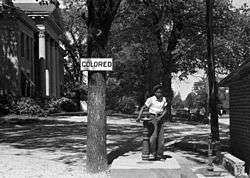
Racial and ethnic discrimination differentiates individuals on the basis of real and perceived racial and ethnic differences and leads to various forms of the ethnic penalty.[42] It has been official government policy in several countries, such as South Africa during the apartheid era. Discriminatory policies towards ethnic minorities include the race-based discrimination against ethnic Indians and Chinese in Malaysia[43] After the Vietnam war, many Vietnamese refugees moved to the United States, where they face discrimination.[44]
As of 2013, aboriginal people (First Nations, such as the Métis, and Inuit) comprise 4 percent of Canada's population, but they account for 23.2 percent of the country's total federal prison population.[45] According to the Australian government's June 2006 publication of prison statistics, Aborigines account for 24% of the overall prison population in Australia.[46]
In 2004, the Māori made up just 15% of the total population of New Zealand but they accounted for 49.5% of all prisoners in the country. Māori were entering prison at eight times the rate of non-Māori.[47] A quarter of the people in England's prisons are members of ethnic minority groups. The Equality and Human Rights Commission found that in England and Wales as of 2010, a black person was five times more likely to be imprisoned than a white person. The discrepancy was attributed to "decades of racial prejudice in the criminal justice system".[48]
In the United States, the racial profiling of minorities by law-enforcement officials has been called racial discrimination.[49]
Within the criminal justice system of the United States, minorities are convicted and imprisoned disproportionately when compared to the majority.[50][51] As early as 1866, the Civil Rights Act and Civil Rights Act of 1871 provided a remedy for intentional racism in employment by private employers and state and local public employers. The Civil Rights Act of 1991 expanded the damages available in Title VII cases and granted Title VII plaintiffs the right to a jury trial.
Racial discrimination in hiring has been shown to exist in both the United States and Europe.[52][53] Using a field experiment, Marianne Bertrand and Sendhil Mullainathan showed that applications from job candidates with white-sounding names received 50 percent more callbacks for interviews than those with African-American-sounding names in the United States at the start of this millennium.[54] A 2009 study by Devah Pager, Bruce Western, and Bart Bonikowski found that black applicants to low-wage jobs were half as likely as identically qualified white applicants to receive callbacks or job offers.[55] More recently, Stijn Baert, Bart Cockx, Niels Gheyle and Cora Vandamme replicated and extended their field experiment in Belgium, Europe. They found that racial discrimination in the labour market is heterogeneous by the labour market tightness in the occupation: compared to natives, candidates with a foreign-sounding name are equally often invited to a job interview in Belgium if they apply for occupations for which vacancies are difficult to fill, but they have to send twice as many applications for occupations for which labor market tightness is low.[56]
Region
Regional or geographic discrimination is a form of discrimination that is based on the region in which a person lives or the region in which a person was born. It differs from national discrimination because it may not be based on national borders or the country in which the victim lives, instead, it is based on prejudices against a specific region of one or more countries. Examples include discrimination against Chinese people who were born in regions of the countryside that are far away from cities that are located within China, and discrimination against Americans who are from the southern or northern regions of the United States. It is often accompanied by discrimination that is based on accent, dialect, or cultural differences.[57]
Religious beliefs
| Freedom of religion | ||||||||||||
|---|---|---|---|---|---|---|---|---|---|---|---|---|
|
Concepts
|
||||||||||||
|
Status by country
|
||||||||||||
|
Religious persecution
|
||||||||||||
| Religion portal | ||||||||||||
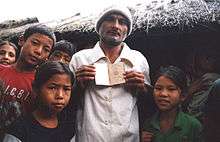
Religious discrimination is valuing or treating people or groups differently because of what they do or do not believe in or because of their feelings towards a given religion. For instance, the indigenous Christian population of the Balkans, known as the "rayah" or the "protected flock", was subjected to discrimination under the Ottoman Kanun–i–Rayah. The word is sometimes translated as 'cattle' rather than 'flock' or 'subjects' in order to emphasize the Christian population's inferior status to that of the Muslim rayah.[58]
Restrictions on the types of occupations that Jewish people could hold were imposed by Christian authorities. Local rulers and church officials closed many professions to religious Jews, pushing them into marginal roles that were considered socially inferior, such as tax and rent collecting and moneylending, occupations that were only tolerated as a "necessary evil".[59] The number of Jews who were permitted to reside in different places was limited; they were concentrated in ghettos and banned from owning land. In Saudi Arabia, non-Muslims are not allowed to publicly practice their religions and they cannot enter Mecca and Medina.[60][61] Furthermore, private non-Muslim religious gatherings might be raided by the religious police.[61]
In a 1979 consultation on the issue, the United States commission on civil rights defined religious discrimination in relation to the civil rights which are guaranteed by the Fourteenth Amendment. Whereas religious civil liberties, such as the right to hold or not to hold a religious belief, are essential for Freedom of Religion (in the United States as secured by the First Amendment), religious discrimination occurs when someone is denied "equal protection under the law, equality of status under the law, equal treatment in the administration of justice, and equality of opportunity and access to employment, education, housing, public services and facilities, and public accommodation because of their exercise of their right to religious freedom".[62]
Sex, sex characteristics, gender, and gender identity
Though gender discrimination and sexism refer to beliefs and attitudes in relation to the gender of a person, such beliefs and attitudes are of a social nature and do not, normally, carry any legal consequences. Sex discrimination, on the other hand, may have legal consequences. Though what constitutes sex discrimination varies between countries, the essence is that it is an adverse action taken by one person against another person that would not have occurred had the person been of another sex. Discrimination of that nature is considered a form of prejudice and in certain enumerated circumstances is illegal in many countries.
Sexual discrimination can arise in different contexts. For instance, an employee may be discriminated against by being asked discriminatory questions during a job interview, or by an employer not hiring or promoting, unequally paying, or wrongfully terminating, an employee based on their gender.
Sexual discrimination can also arise when the dominant group holds a bias against the minority group. One such example is Wikipedia. In the Wikipedian community, around 13 percent of registered users are women.[64] This creates gender imbalances, and leaves room for systemic bias. Women are not only more harshly scrutinized, but the representation of women authors are also overlooked. Relative to men, across all source lists, women have a 2.6 greater odds of omission in Wikipedia.[65] In an educational setting, there could be claims that a student was excluded from an educational institution, program, opportunity, loan, student group, or scholarship because of their gender. In the housing setting, there could be claims that a person was refused negotiations on seeking a house, contracting/leasing a house or getting a loan based on their gender. Another setting where there have been claims of gender discrimination is banking; for example if one is refused credit or is offered unequal loan terms based on one's gender.[66] As with other forms of unlawful discrimination, there are two types of sex discrimination – direct discrimination and indirect discrimination. Direct sex discrimination is fairly easy to spot – 'Barmaid wanted', but indirect sex discrimination, where an unnecessary requirement puts one sex at a disproportionate disadvantage compared to the opposite sex, is sometimes less easy to spot, although some are obvious – 'Bar person wanted – must look good in a mini skirt'.[67] Another setting where there is usually gender discrimination is when one is refused to extend their credit, refused approval of credit/loan process, and if there is a burden of unequal loan terms based on one's gender. Socially, sexual differences have been used to justify different roles for men and women, in some cases giving rise to claims of primary and secondary roles. While there are alleged non-physical differences between men and women, major reviews of the academic literature on gender difference find only a tiny minority of characteristics where there are consistent psychological differences between men and women, and these relate directly to experiences grounded in biological difference.[68]
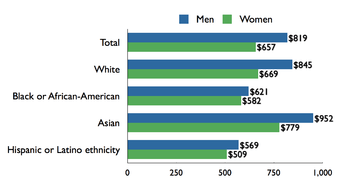
Unfair discrimination usually follows the gender stereotyping held by a society.[70]
The United Nations had concluded that women often experience a "glass ceiling" and that there are no societies in which women enjoy the same opportunities as men.[71] The term "glass ceiling" is used to describe a perceived barrier to advancement in employment based on discrimination, especially sex discrimination.[72] In the United States in 1995, the Glass Ceiling Commission, a government-funded group, stated: "Over half of all Master's degrees are now awarded to women, yet 95% of senior-level managers, of the top Fortune 1000 industrial and 500 service companies are men. Of them, 97% are white." In its report, it recommended affirmative action, which is the consideration of an employee's gender and race in hiring and promotion decisions, as a means to end this form of discrimination.[73] As of 2010, women accounted for 51% of workers in high-paying management, professional, and related occupations. They outnumbered men in such occupations as public relations managers, financial managers, and human resource managers.[74]
In addition, women are found to experience a sticky floor. While a glass ceiling implies that women are less like to reach the top of the job ladder, a sticky floor is defined as the pattern that women are, compared to men, less likely to start to climb the job ladder. A sticky floor is related to gender differences at the bottom of the wage distribution. It might be explained by both employer discrimination and gender differences in career aspirations.[75]
Intersex persons experience discrimination due to innate, atypical sex characteristics. Multiple jurisdictions now protect individuals on grounds of intersex status or sex characteristics. South Africa was the first country to explicitly add intersex to legislation, as part of the attribute of 'sex'.[76] Australia was the first country to add an independent attribute, of 'intersex status'.[77][78] Malta was the first to adopt a broader framework of 'sex characteristics', through legislation that also ended modifications to the sex characteristics of minors undertaken for social and cultural reasons.[79][80]
Transgender individuals, whether trans women, trans men, or non-binary, often experience transphobic problems that often lead to dismissals, underachievement, difficulty in finding a job, social isolation, and, occasionally, violent attacks against them.
Nevertheless, the problem of gender discrimination does not stop at transgender individuals or with women. Men are often the victim in certain areas of employment as men begin to seek work in office and childcare settings traditionally perceived as "women's jobs". One such situation seems to be evident in a recent case concerning alleged YMCA discrimination and a Federal Court Case in Texas.[81] The case actually involves alleged discrimination against both men and black people in childcare, even when they pass the same strict background tests and other standards of employment. It is currently being contended in federal court, as of fall 2009.
Discrimination in slasher films is relevant. Gloria Cowan had a research group study on 57 different slasher films. Their results showed that the non-surviving females were more frequently sexual than the surviving females and the non-surviving males. Surviving as a female slasher victim was strongly associated with the absence of sexual behavior. In slasher films, the message appears to be that sexual women get killed and only the pure women survive, thus reinforcing the idea that female sexuality can be costly.[82]
Sexual orientation
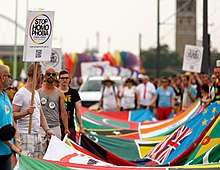
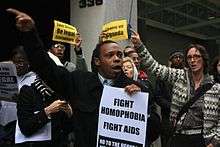
One's sexual orientation is a "predilection for homosexuality, heterosexuality, or bisexuality".[83] Like most minority groups, homosexuals and bisexuals are vulnerable to prejudice and discrimination from the majority group. They may experience hatred from others because of their sexuality; a term for such hatred based upon one's sexual orientation is often called homophobia. Many continue to hold negative feelings towards those with non-heterosexual orientations and will discriminate against people who have them or are thought to have them. People of other uncommon sexual orientations also experience discrimination. One study found its sample of heterosexuals to be more prejudiced against asexual people than to homosexual or bisexual people.[84]
Employment discrimination based on sexual orientation varies by country. Revealing a lesbian sexual orientation (by means of mentioning an engagement in a rainbow organisation or by mentioning one's partner name) lowers employment opportunities in Cyprus and Greece but overall, it has no negative effect in Sweden and Belgium.[85][86][87][88] In the latter country, even a positive effect of revealing a lesbian sexual orientation is found for women at their fertile ages.
Besides these academic studies, in 2009, ILGA published a report based on research carried out by Daniel Ottosson at Södertörn University College, Stockholm, Sweden. This research found that of the 80 countries around the world that continue to consider homosexuality illegal, five carry the death penalty for homosexual activity, and two do in some regions of the country.[89] In the report, this is described as "State sponsored homophobia".[90] This happens in Islamic states, or in two cases regions under Islamic authority.[91][92] On February 5, 2005, the IRIN issued a reported titled "Iraq: Male homosexuality still a taboo". The article stated, among other things that honor killings by Iraqis against a gay family member are common and given some legal protection.[93] In August 2009, Human Rights Watch published an extensive report detailing torture of men accused of being gay in Iraq, including the blocking of men's anuses with glue and then giving the men laxatives.[94] Although gay marriage has been legal in South Africa since 2006, same-sex unions are often condemned as "un-African".[95] Research conducted in 2009 shows 86% of black lesbians from the Western Cape live in fear of sexual assault.[96]
A number of countries, especially those in the Western world, have passed measures to alleviate discrimination against sexual minorities, including laws against anti-gay hate crimes and workplace discrimination. Some have also legalized same-sex marriage or civil unions in order to grant same-sex couples the same protections and benefits as opposite-sex couples. In 2011, the United Nations passed its first resolution recognizing LGBT rights.
Species
Speciesism is intolerance or discrimination on the basis of species membership.[97][98] It involves treating members of one species as morally more important than members of other species even when their moral interests are equivalent.[99][100] It is thought that speciesism plays a role in inspiring or justifying cruelty in the forms of factory farming, the use of animals for entertainment such as in bullfighting and rodeos, the taking of animals' fur and skin, experimentation on animals,[101] and the refusal to aid wild animals that suffer due to natural processes.[102][103]
Drug use
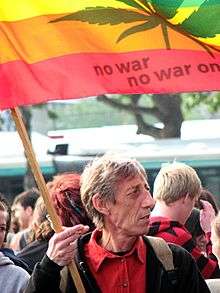
Drug use discrimination is the unequal treatment people experience because of the drugs they use.[104] People who use or have used illicit drugs may face discrimination in employment, welfare, housing, child custody, and travel,[105][106][107][108] in addition to imprisonment, asset forfeiture, and in some cases forced labor, torture, and execution.[109][110] Though often prejudicially stereotyped as deviants and misfits, most drug users are well-adjusted and productive members of society.[111][112] Drug prohibitions may have been partly motivated by racism and other prejudice against minorities,[113][114][115] and racial disparities have been found to exist in the enforcement and prosecution of drug laws.[116][117][118] Discrimination due to illicit drug use was the most commonly reported type of discrimination among Blacks and Latinos in a 2003 study of minority drug users in New York City, double to triple that due to race.[119] People who use legal drugs such as tobacco and prescription medications may also face discrimination.[120][121][122]
Ideas of self-ownership and cognitive liberty affirm rights to use drugs, whether for medicine[123][124][125] recreation,[126][127][128] or spiritual fulfilment.[129][130][131] Those espousing such ideas question the legality of drug prohibition and cite the rights and freedoms enshrined in such documents as the U.S. Declaration of Independence, the U.S. Constitution and Bill of Rights,[132][133] the European Convention on Human Rights,[134][135] and the Universal Declaration of Human Rights,[136] as protecting personal drug choices. They are inspired by and see themselves following in the tradition of those who have struggled against other forms of discrimination in the past.[137]
Drug policy reform organizations such as the Drug Policy Alliance,[138] the Drug Equality Alliance,[139] the Transform Drug Policy Foundation,[140] and the Beckley Foundation[141] have highlighted the issue of stigma and discrimination in drug policy. The Partnership for Drug-Free Kids also recognizes this issue[142] and shares on its website stories that "break through the stigma and discrimination that people with drug or drinking problems often face."[143]
A report issued by the Global Commission on Drug Policy, critical of the global war on drugs,[144] states, under "Undermining Human Rights, Fostering Discrimination":
Punitive approaches to drug policy are severely undermining human rights in every region of the world. They lead to the erosion of civil liberties and fair trial standards, the stigmatization of individuals and groups – particularly women, young people, and ethnic minorities – and the imposition of abusive and inhumane punishments.[145]
Although still illegal at the federal level, about half of U.S. states have legalized marijuana for medical use and several of those states have laws, or are considering legislation, specifically protecting medical marijuana patients from discrimination in such areas as education, employment, housing, child custody, and organ transplantation.[146][147][148]
Reverse discrimination
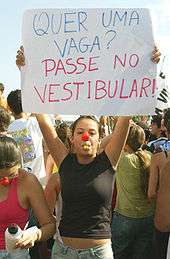
In the US, a government policy which is known as affirmative action was instituted in order to encourage employers and universities to seek out and accept groups such as African Americans and women, who have been subject to discrimination for a long time.[149]
Some attempts at antidiscrimination have been criticized as reverse discrimination. In particular, minority quota systems such as affirmative action) may discriminate against members of a dominant or majority group or members of other minority groups. In its opposition to race preferences, the American Civil Rights Institute's Ward Connerly stated, "There is nothing positive, affirmative, or equal about 'affirmative action' programs that give preference to some groups based on race."[150]
Secondary phenomenon
There are instances in which groups, victims of racialistic practices, have themselves applied doctrines with racist implications in their struggle for freedom. Such an attitude is a secondary phenomenon, a reaction stemming from one's search for an identity which prior racist theory and racialistic practices denied them. The new forms of racist ideology, resulting from this prior exploitation, are a product of a political struggle.[151]
Legislation
- Ontario Human Rights Code 1962
- Canadian Human Rights Act 1977 [152]
- Sex Discrimination Ordinance (1996)
- Prohibition of Discrimination in Products, Services and Entry into Places of Entertainment and Public Places Law, 2000
- Employment (Equal Opportunities) Law, 1988
- Article 137c, part 1 of Wetboek van Strafrecht prohibits insults towards a group because of its race, religion, sexual orientation (straight or gay), handicap (somatically, mental or psychiatric) in public or by speech, by writing or by a picture. Maximum imprisonment one year of imprisonment or a fine of the third category.[153][154]
- Part 2 increases the maximum imprisonment to two years and the maximum fine category to 4,[155] when the crime is committed as a habit or is committed by two or more persons.
- Article 137d prohibits provoking to discrimination or hate against the group described above. Same penalties apply as in article 137c.[156]
- Article 137e part 1 prohibits publishing a discriminatory statement, other than in formal message, or hands over an object (that contains discriminatory information) otherwise than on his request. Maximum imprisonment is 6 months or a fine of the third category.[153][157]
- Part 2 increases the maximum imprisonment to one year and the maximum fine category to 4,[155] when the crime is committed as a habit or committed by two or more persons.
- Article 137f prohibits supporting discriminatory activities by giving money or goods. Maximum imprisonment is 3 months or a fine of the second category.[158][159]
United Kingdom
- Equal Pay Act 1970 – provides for equal pay for comparable work.
- Sex Discrimination Act 1975 – makes discrimination against women or men, including discrimination on the grounds of marital status, illegal in the workplace.
- Human Rights Act 1998 – provides more scope for redressing all forms of discriminatory imbalances.
United States
- Equal Pay Act of 1963[160] – (part of the Fair Labor Standards Act) – prohibits wage discrimination by employers and labor organizations based on sex.
- Civil Rights Act of 1964 – many provisions, including broadly prohibiting discrimination in the workplace including hiring, firing, workforce reduction, benefits, and sexually harassing conduct.[161]
- Fair Housing Act of 1968 prohibited discrimination in the sale or rental of housing based on race, color, national origin, religion, sex, familial status, or disability. The Office of Fair Housing and Equal Opportunity is charged with administering and enforcing the Act.
- Pregnancy Discrimination Act, which amended Title VII of the Civil Rights Act of 1964 – covers discrimination based upon pregnancy in the workplace.[162]
- Violence Against Women Act
- Racism is still rampant in real estate.[163]
United Nations documents
Important UN documents addressing discrimination include:
- The Universal Declaration of Human Rights is a declaration adopted by the United Nations General Assembly on 10 December 1948. It states that:" Everyone is entitled to all the rights and freedoms set forth in this Declaration, without distinction of any kind, such as race, colour, sex, language, religion, political or other opinion, national or social origin, property, birth or other status."[164]
- The International Convention on the Elimination of All Forms of Racial Discrimination (ICERD) is a United Nations convention. The Convention commits its members to the elimination of racial discrimination. The convention was adopted and opened for signature by the United Nations General Assembly on 21 December 1965, and entered into force on 4 January 1969.
- The Convention on the Elimination of All Forms of Discrimination against Women (CEDAW) is an international treaty adopted in 1979 by the United Nations General Assembly. Described as an international bill of rights for women, it came into force on 3 September 1981.
- The Convention on the Rights of Persons with Disabilities is an international human rights instrument treaty of the United Nations. Parties to the Convention are required to promote, protect, and ensure the full enjoyment of human rights by persons with disabilities and ensure that they enjoy full equality under the law. The text was adopted by the United Nations General Assembly on 13 December 2006, and opened for signature on 30 March 2007. Following ratification by the 20th party, it came into force on 3 May 2008.
Theories
Social theories such as egalitarianism assert that social equality should prevail. In some societies, including most developed countries, each individual's civil rights include the right to be free from government sponsored social discrimination.[165] Due to a belief in the capacity to perceive pain or suffering shared by all animals, "abolitionist" or "vegan" egalitarianism maintains that the interests of every individual (regardless its species), warrant equal consideration with the interests of humans, and that not doing so is "speciesist".[166]
Labeling theory
Discrimination, in labeling theory, takes form as mental categorization of minorities and the use of stereotype. This theory describes difference as deviance from the norm, which results in internal devaluation and social stigma[167] that may be seen as discrimination. It is started by describing a "natural" social order. It is distinguished between the fundamental principle of fascism and social democracy. The Nazis in 1930s-era Germany and the pre-1990 Apartheid government of South Africa used racially discriminatory agendas for their political ends. This practice continues with some present day governments.[168]
Game theory
Economist Yanis Varoufakis (2013) argues that "discrimination based on utterly arbitrary characteristics evolves quickly and systematically in the experimental laboratory", and that neither classical game theory nor neoclassical economics can explain this.[169] Varoufakis and Shaun Hargreaves-Heap (2002) ran an experiment where volunteers played a computer-mediated, multiround hawk-dove game (HD game). At the start of each session, each participant was assigned a color at random, either red or blue. At each round, each player learned the color assigned to his or her opponent, but nothing else about the opponent. Hargreaves-Heap and Varoufakis found that the players' behavior within a session frequently developed a discriminatory convention, giving a Nash equilibrium where players of one color (the "advantaged" color) consistently played the aggressive "hawk" strategy against players of the other, "disadvantaged" color, who played the acquiescent "dove" strategy against the advantaged color. Players of both colors used a mixed strategy when playing against players assigned the same color as their own.
The experimenters then added a cooperation option to the game, and found that disadvantaged players usually cooperated with each other, while advantaged players usually did not. They state that while the equilibria reached in the original HD game are predicted by evolutionary game theory, game theory does not explain the emergence of cooperation in the disadvantaged group. Citing earlier psychological work of Matthew Rabin, they hypothesize that a norm of differing entitlements emerges across the two groups, and that this norm could define a "fairness" equilibrium within the disadvantaged group.[170]
State vs. free market
It is debated as to whether or not markets discourage discrimination brought about by the state. One argument is that since discrimination restricts access to customers and incurs additional expense, market logic will punish discrimination. Opposition by companies to "Jim Crow" segregation laws is an example of this.[171] An alternative argument is that markets don't necessarily undermine discrimination, as it is argued that if discrimination is profitable by catering to the "tastes" of individuals (which is the point of the market), then the market will not punish discrimination. It is argued that micro economic analysis of discrimination uses unusual methods to determine its effects (using explicit treatment of production functions) and that the very existence of discrimination in employment (defined as wages which differ from marginal product of the discriminated employees) in the long run contradicts claims that the market will function well and punish discrimination.[172][173] Furthermore, economic actors may have imperfect information and statistical discrimination may occur rationally and without prejudice.
See also
- Ableism
- Adultism
- Affirmative action
- Afrophobia
- Ageism
- Allport's Scale
- Animal industrial complex
- Anti-Arabism
- Anti-Catholicism
- Anti-discrimination law
- Anti-intellectualism
- Anti-Mormonism
- Anti-Protestantism
- Antisemitism
- Antiziganism
- Apartheid
- Apostasy
- Apostasy in Islam
- Arab slave trade
- Atlantic slave trade
- Bias
- Caste
- Classicide
- Colorism
- Cultural assimilation
- Dignity
- Discrimination against atheists
- Discrimination against members of the armed forces in the United Kingdom
- Discrimination against people with HIV/AIDS
- Economic discrimination
- Employment discrimination
- Egalitarianism
- Equal opportunity
- Equal rights
- Ethnic cleansing
- Ethnic penalty
- Ethnocentrism
- Favoritism
- Genetic discrimination
- Genocide
- Hate crime
- Hate group
- Heightism
- Hispanophobia
- Homophobia
- Identicide
- Ingroups and outgroups
- Institutionalized discrimination
- Intersectionality
- Intersex human rights
- Islamophobia
- Jim Crow laws
- List of countries by discrimination and violence against minorities
- List of phobias
- Lookism
- Microaggression theory
- Nativism (politics)
- Oppression
- Persecution
- Politicide
- Prejudice
- Racial segregation
- Racism
- Realistic conflict theory
- Religious intolerance
- Religious persecution
- Religious segregation
- Religious violence
- Replication crisis
- Reverse discrimination
- Second-class citizen
- Sexism
- Sizeism
- Slavery
- Social conflict
- Speciesism
- State racism
- Statistical discrimination (economics)
- Stereotype
- Stigma management
- Structural violence
- Supremacism
- Taste-based discrimination
- Xenophobia
References
- "discrimination, definition". Cambridge Dictionaries Online. Cambridge University. Retrieved 29 March 2013.
- Introduction to sociology. 7th ed. New York: W. W. Norton & Company Inc, 2009. p. 334.
- "Definition of discrimination; Origin". Oxford Dictionaries. Oxford University. Retrieved 14 January 2013.
- Introduction to sociology (Print) (7th ed.). New York: W. W. Norton & Company Inc. 2009. p. 324.
- Lippert-Rasmussen, Kasper (2006). "Private Discrimination: A Prioritarian, Desert-Accommodating Account". San Diego Law Review. 43: 817–856.
- Horta, Oscar (2010). "Discrimination in Terms of Moral Exclusion". Theoria. 76 (4): 314–332. doi:10.1111/j.1755-2567.2010.01080.x.
- Thompson, Neil (2016). Anti-Discriminatory Practice: Equality, Diversity and Social Justice. Palgrave Macmillan. ISBN 978-1-137-58666-7.
- Sherif, M. (1967). Group conflict and co-operation. London: Routledge.
- Tajfel, H.; Turner, J. C. (1979). "An integrative theory of intergroup conflict". In Austin, W.G.; Worchel, S. (eds.). The social psychology of intergroup relations. Monterey, CA: Brooks/Cole. pp. 33–47.
- Rubin, M.; Hewstone, M.; et al. (2004). "Social identity, system justification, and social dominance: Commentary on Reicher, Jost et al., and Sidanius et al". Political Psychology. 25 (6): 823–844. doi:10.1111/j.1467-9221.2004.00400.x.
- "United Nations CyberSchoolBus: What is discrimination?". Archived from the original on 2014-06-01.
- "Definition of Ageism". Oxford Dictionaries. Oxford University Press. Retrieved 4 December 2012.
- Kirkpatrick, George R.; Katsiaficas, George N.; Kirkpatrick, Robert George; Mary Lou Emery (1987). Introduction to critical sociology. Ardent Media. p. 261. ISBN 978-0-8290-1595-9. Retrieved 28 January 2011.
- Wilkinson J and Ferraro K, "Thirty Years of Ageism Research". In Nelson T (ed). Ageism: Stereotyping and Prejudice Against Older Persons. Massachusetts Institute of Technology, 2002
- "Young and Oppressed". youthrights.org. Retrieved on 11 April 2012. Archived July 28, 2011, at the Wayback Machine
- Lahey, J. (2005) Do Older Workers Face Discrimination? Boston College. Archived April 14, 2012, at the Wayback Machine
- Baert, S., Norga, J., Thuy, Y., Van Hecke, M. (In press) Getting Grey Hairs in the Labour Market: An Alternative Experiment on Age Discrimination Journal of Economic Psychology.
- (2006) How Ageist is Britain? London: Age Concern. Archived October 27, 2005, at the Wayback Machine
- Discrimination, UNICEF
- "Global Caste Discrimination". Human Rights Watch. Archived from the original on 15 November 2008. Retrieved 26 April 2016.
- "Caste – The Facts". Archived from the original on August 11, 2010.
- "India: Official Dalit population exceeds 200 million". International Dalit Solidarity Network. 29 May 2013. Retrieved 30 July 2014.
- "Attacks on goths, punks and emos are 'hate crimes'". Channel 4 News. 4 April 2013. Retrieved 4 November 2019.
- Sedgwick, Mark (4 April 2013). "How are goths and emos defined?". BBC News. Retrieved 4 November 2019.
- Vornholt, Katharina; Sjir Uitdewilligen; Frans J.N. Nijhuis (December 2013). "Factors Affecting the Acceptance of People with Disabilities at Work: A Literature Review". Journal of Occupational Rehabilitation. 23 (4): 463–75. doi:10.1007/s10926-013-9426-0. PMID 23400588.
- Brodzinsky, Sibylla (October 3, 2011). "Colombian clans who speak no Spanish mocked with joke names on ID cards" – via www.theguardian.com.
- Hossain & Tollefson 2006, p. 345.
- Silberzhan, Raphael (May 19, 2013). "It Pays to be Herr Kaiser". Psychological Science. 24 (12): 2437–2444. doi:10.1177/0956797613494851. PMID 24113624.
- Laham, Simon (December 9, 2011). "The name-pronunciation effect: Why people like Mr. Smith more than Mr. Colquhoun". Journal of Experimental Social Psychology. 48 (2012): 752–756. doi:10.1016/j.jesp.2011.12.002.
- Cotton, John (July 2007). "The "name game": affective and hiring reactions to first names". Journal of Managerial Psychology. 23 (1): 18–39. doi:10.1108/02683940810849648.
- Bertrand, Marianne (September 2004). "Are Emily and Brendan More Employable than Lakisha and Jamaal?" (PDF). The American Economic Review. 94 (4): 991–1013. doi:10.1257/0002828042002561.
- Easton, Stephen (June 30, 2017). "Blind recruiting study suggests positive discrimination common in the APS". The Mandarin.
- Smith, Jacquelyn (November 4, 2014). "Here's What Recruiters Look At In The 6 Seconds They Spend On Your Résumé". Business Insider.
- "No names, no bias". The Economist. October 29, 2015.
- Silberzhan, Raphael; Simonsohn, Uri; Uhlmann, Eric (February 4, 2014). "Matched-Names Analysis Reveals No Evidence of Name-Meaning Effects: A Collaborative Commentary on Silberzahn and Uhlmann" (PDF). Psychological Science. 25 (7): 1504–1505. doi:10.1177/0956797614533802. PMID 24866920.
- "The Power of Names". The New York Times. May 29, 2013.
- Race, Color, National Origin and Ancestry, State of Wisconsin Archived October 24, 2012, at the Wayback Machine
- "Race and National Origin Discrimination". Office for Civil Rights. U.S. Department of Education. Retrieved 16 December 2017.
- Christiane Schwieren, Mechanisms Underlying Nationality-Based Discrimination in Teams. A Quasi-Experiment Testing Predictions From Social Psychology and Microeconomics Archived 2015-12-31 at the Wayback Machine, Maastricht University
- Ayesha Almazroui. "Emiratisation won't work if people don't want to learn". Retrieved 26 April 2016.
- "'Western workers favoured in UAE', survey respondents say". The National. Retrieved 2019-07-08.
- Carmichael, F.; Woods, R. (2000). "Ethnic Penalties in Unemployment and Occupational Attainment: Evidence for Britain". International Review of Applied Economics. 14 (1): 71–98. doi:10.1080/026921700101498.
- "Malaysia's lingering ethnic divide". March 4, 2008. BBC News.
- Levine, Bertram. (2005). "Not All Black and White". J. Cropp (Ed.), Resolving Racial Conflict, 193-218. London: University of Missouri Press.
- "Aboriginal Offenders: A Critical Situation". Office of the Correctional Investigator, Government of Canada. February 2013.
- "Prisoners in Australia, 2006". Australian Bureau of Statistics. 2006-12-14. Retrieved 2007-05-04.
- "New Zealand". U.S. Department of State. Retrieved 26 April 2016.
- Ramesh, Randeep. "More black people jailed in England and Wales proportionally than in US". The Guardian. October 11, 2010
- Callahan, Gene; Anderson, William (August–September 2001). "The Roots of Racial Profiling". Reason Online. Reason Foundation.
- "How is the Criminal Justice System Racist?" (PDF).
- Blacks Hardest Hit by Incarceration Policy Archived 2015-03-13 at the Wayback Machine. Human Rights Watch. June 5, 2008.
- Kalev, Alexandra; Dobbin, Frank; Kelly, Erin (2006-08-01). "Best Practices or Best Guesses? Assessing the Efficacy of Corporate Affirmative Action and Diversity Policies". American Sociological Review. 71 (4): 589–617. doi:10.1177/000312240607100404. ISSN 0003-1224.
- Kang, Sonia K.; DeCelles, Katherine A.; Tilcsik, András; Jun, Sora (2016-09-01). "Whitened Résumés: Race and Self-Presentation in the Labor Market". Administrative Science Quarterly. 61 (3): 469–502. doi:10.1177/0001839216639577. hdl:1807/72386. ISSN 0001-8392.
- Bertrand, M., Mullainathan, S. (2004) Are Emily and Greg More Employable Than Lakisha and Jamal? A Field Experiment on Labor Market Discrimination American Economic Review, 94, 991-1013
- Pager, D.; Bonikowski, B.; Western, B. (1 October 2009). "Discrimination in a Low-Wage Labor Market: A Field Experiment". American Sociological Review. 74 (5): 777–799. doi:10.1177/000312240907400505. PMC 2915472. PMID 20689685.
- Baert, S., Cockx, B., Gheyle, N., Vandamme, C. (2015) Is There Less Discrimination in Occupations Where Recruitment is Difficult? Industrial and Labor Relations Review, 68, 467-500.
- "Accent Discrimination Law and Legal Definition". USLegal.
- Maan Z. Madina, Arabic-English Dictionary of the Modern Literary Language, 1973.
- "Did Discrimination Enhance Intelligence of Jews?". National Geographic News. July 18, 2005 Archived December 6, 2010, at the Wayback Machine
- Sandra Mackey's account of her attempt to enter Mecca in Mackey, Sandra (1987). The Saudis: Inside the Desert Kingdom. W. W. Norton & Company. pp. 63–64. ISBN 978-0-393-32417-4.
- Department Of State. The Office of Electronic Information, Bureau of Public Affairs (2008-09-19). "Saudi Arabia". 2001-2009.state.gov. Retrieved 2019-07-24.
- U.S. Commission on Civil Rights, 1979: Religious discrimination. A neglected issue. A consultation sponsored by the United States Commission on Civil Rights, Washington. D.C., April 9–10, 1979
- "OECD Employment Outlook 2008 – Statistical Annex OECD, Paris" (PDF). OECD. 2008. p. 358. Archived from the original (PDF) on December 6, 2008.
- Glott, R., Schmidt, P., & Ghosh, R. A. (March 2010). "Wikipedia survey—Overview of results" (PDF). UNI-MERIT. Archived from the original (PDF) on April 14, 2010.CS1 maint: uses authors parameter (link)
- Reagle, J., & Rhue, L. (2011). "Gender Bias in Wikipedia and Britannica". International Journal of Communication. 5: 1138–1158.CS1 maint: uses authors parameter (link)
- Wilson, F. (2003). Organizational Behaviour and Gender (2nd ed.). Aldershot: Ashgate. ISBN 978-0-7546-0900-1.
- "Sex Discrimination". Citation.co.uk.
- Hyde, J. S. (2005). "The Gender Similarities Hypothesis" (PDF). American Psychologist. 60 (6): 581–592. CiteSeerX 10.1.1.374.1723. doi:10.1037/0003-066x.60.6.581. PMID 16173891.
- U.S. Bureau of Labor Statistics. Highlights of Women’s Earnings in 2009. Report 1025, June 2010.
- Raymond F. Gregory, Women and Workplace Discrimination: Overcoming Barriers to Gender Equality, Piscataway, NJ: Rutgers University Press, 2003
- Cynthia Fuchs Epstein, Glass Ceilings and Open Doors, Fordham Law Review, 64.2, 1995, pp.291-449; Carol Hymowitz and Timothy Schellhardt, The Glass Ceiling: Why Women Can’t Seem to Break the Invisible Barrier that Blocks them from the Top Jobs, The Wall Street Journal, 4, March 24, 1986, pp.10-40
- Kenneth Bolton, Joe R. Feagin Black in Blue: African-American Police Officers and Racism, Routledge, 2004
- "A Solid Investment: Making Full Use of the Nation's Human Capital". November 1995. Retrieved 2008-05-23.
- "Quick Stats on Women Workers, 2010". U.S. Department of Labor, Bureau of Labor Statistics, Employment and Earnings, 2010 Annual Averages and the Monthly Labor Review.
- Baert, S., De Pauw, A.-S., Deschacht, N. (Forthcoming) [Do Employer Preferences Contribute to Sticky Floors?] Industrial & Labor Relations Review.
- Judicial Matters Amendment Act, No. 22 of 2005, Republic of South Africa, Vol. 487, Cape Town, 11 January 2006.
- "Australian Parliament, Explanatory Memorandum to the Sex Discrimination Amendment (Sexual Orientation, Gender Identity and Intersex Status) Bill 2013". Archived from the original on 19 December 2014. Retrieved 6 October 2014.
- We welcome the Senate Inquiry report on the Exposure Draft of the Human Rights and Anti-Discrimination Bill 2012, Organisation Intersex International Australia, 21 February 2013.
- Cabral, Mauro (April 8, 2015). "Making depathologization a matter of law. A comment from GATE on the Maltese Act on Gender Identity, Gender Expression and Sex Characteristics". Global Action for Trans Equality. Archived from the original on July 4, 2015. Retrieved 2015-07-03.
- OII Europe (April 1, 2015). "OII-Europe applauds Malta's Gender Identity, Gender Expression and Sex Characteristics Act. This is a landmark case for intersex rights within European law reform". Retrieved 2015-07-03.
- Noack v YMCA of Greater Houston Area, 132, S. Ct.425 (US, 2011)
- Cowan, Glora; O'Brien, Margaret (1990). "Gender and Survival vs. Death in Slasher Films: A Content Analysis". Sex Roles. 23 (3–4): 187–196. doi:10.1007/BF00289865.
- World English Dictionary, "Sexual Orientation"
- MacInnis, Cara C.; Hodson, Gordon (2012). "Intergroup bias toward "Group X": Evidence of prejudice, dehumanization, avoidance, and discrimination against asexuals". Group Processes & Intergroup Relations. 15 (6): 725–743. doi:10.1177/1368430212442419.
- Drydakis, Nick (2011). "Women's Sexual Orientation and Labor Market Outcomes in Greece". Feminist Economics. 17: 89–117. doi:10.1080/13545701.2010.541858.
- Drydakis, Nick (2014). "Sexual orientation discrimination in the Cypriot labour market. Distastes or uncertainty?". International Journal of Manpower. 35 (5): 720–744. doi:10.1108/IJM-02-2012-0026. hdl:10419/62444.
- Ahmed, A. M., Andersson, L., Hammarstedt, M. (2011) Are gays and lesbians discriminated against in the hiring situation? Archived 2015-05-29 at the Wayback Machine Institute for Labour Market Policy Evaluation Working Paper Series 21.
- Baert, Stijn (2014). "Career lesbians. Getting hired for not having kids?". Industrial Relations Journal. 45 (6): 543–561. CiteSeerX 10.1.1.467.2102. doi:10.1111/irj.12078.
- "New Benefits for Same-Sex Couples May Be Hard to Implement Abroad". ABC News. June 22, 2009.
- "ILGA: 2009 Report on State Sponsored Homophobia (2009)" (PDF). Archived from the original (PDF) on May 2, 2010.
- "ILGA:7 countries still put people to death for same-sex acts". Archived from the original on October 29, 2009.
- "Islamic views of homosexuality". Archived from the original on 15 April 2015. Retrieved 26 April 2016.
- "AU welcomes progress in peace process". IRIN. 2004-09-29. Retrieved 26 April 2016.
- "They Want Us Exterminated". Human Rights Watch. August 16, 2009.
- Harrison, Rebecca. "South African gangs use rape to "cure" lesbians". Reuters. March 13, 2009.
- Kelly, Annie (2009-03-12). "Raped and killed for being a lesbian: South Africa ignores 'corrective' attacks". The Guardian.
- "The Case Against Speciesism". Sentience Politics. 26 November 2018. Archived from the original on 22 June 2016. Retrieved 2 December 2018.
- Yancy, George; Singer, Peter (27 May 2015). "Peter Singer: On Racism, Animal Rights and Human Rights". The Stone. New York Times. Retrieved 3 December 2018.
- Duignan, Brian. "Speciesism". Encyclopaedia Britannica. Retrieved 3 December 2018.
- "Speciesism". Animal Ethics. 7 January 2014. Retrieved 3 December 2018.
- Cameron, Janet (11 April 2014). "Peter Singer on Suffering and the Consequences of "Speciesism"". Decoded Past. Archived from the original on 28 March 2019. Retrieved 3 December 2018.
- Horta, Oscar (5 July 2016). "Changing attitudes towards animals in the wild and speciesism". Animal Sentience. 1 (7). ISSN 2377-7478.
- Horta, Oscar (5 January 2015). "Why the Situation of Animals in the Wild Should Concern Us". Animal Charity Evaluators. Retrieved 13 August 2019.
- Ahern J, Stuber J, Galea S (May 2007). "Stigma, discrimination and the health of illicit drug users". Drug and Alcohol Dependence. 88 (2–3): 188–96. doi:10.1016/j.drugalcdep.2006.10.014. PMID 17118578.
In addition to the burdens of stigmatization, those who use illicit drugs experience discrimination." "We define drug use discrimination as experiences of rejection and unequal treatment attributed to drug use.
- Della Costa C (2015-06-15). "How Employee Drug Testing Targets the Poor and Minorities". The Cheat Sheet. Retrieved 2015-07-02."Roughly 40% of U.S. employees are subjected to drug testing during the hiring process. The rate of employee drug testing has increased 277% since 1987, and drug testing has even expanded to welfare programs in some states."
- Greenhouse L (2002-03-27). "Justices Rule Drug-Eviction Law Is Fair". New York Times. Retrieved 2015-07-02.
- Wyatt K (2014-06-15). "Changing pot laws create gray areas in child-welfare and custody cases". Washington Post. Retrieved 2015-07-01.
- "Nigella Lawson stopped from boarding flight to US after cocaine confession". The Guardian. 2014-04-03. Retrieved 2015-07-05.
The US department of homeland security told the Mail that foreigners who had admitted drug taking were deemed "inadmissible".
- Szalavitz M (2012-08-06). "Human Rights Watch: Hundreds of Thousands Still Tortured in Name of Drug Treatment". Time. Retrieved 2015-07-01.
- Dehghan SK (2012-06-25). "Iranian pair face death penalty after third alcohol offence". The Guardian. Retrieved 2015-07-01."Under Iranian Sharia law, certain crimes such as sodomy, rape, theft, fornication, apostasy and consumption of alcohol for the third time are considered to be "claims of God" and therefore have mandatory death sentences."
- Bennetto J, Todd B (1997-11-05). "Habits: Most drug users are happy, successful people with a taste for the good life". The Independent. Retrieved 2015-07-02."According to a survey of more than 850 people aged between 16 and 24, and 100 in-depth interviews, drug use is commonplace and consumers tend to be independent, lead active lives, and do not lack self-esteem."
- Nicholson T, White J, Duncan D (September 1998). "Drugnet: A Pilot Study of Adult Recreational Drug Use via the WWW". Substance Abuse. 19 (3): 109–121. doi:10.1080/08897079809511380. PMID 12511811.
This survey further documents the existence of a nonclinical population of drug users which is generally healthy, well-adjusted, and productive.
- Block F (2013-01-03). "Racism's Hidden History in the War on Drugs". Huffington Post. Retrieved 2015-07-05.
A 1914 New York Times article proclaimed: "Negro Cocaine 'Fiends' Are a New Southern Menace: Murder and Insanity Increasing Among Lower Class Blacks Because They Have Taken to 'Sniffing.'" A Literary Digest article from the same year claimed that "most of the attacks upon women in the South are the direct result of the cocaine-crazed Negro brain." It comes as no surprise that 1914 was also the year Congress passed the Harrison Tax Act, effectively outlawing opium and cocaine.
- Staples B (2014-07-29). "The Federal Marijuana Ban Is Rooted in Myth and Xenophobia". New York Times. Retrieved 2015-07-05.
As the legal scholars Richard Bonnie and Charles Whitebread explain in their authoritative history, "The Marihuana Conviction," the drug’s popularity among minorities and other groups practically ensured that it would be classified as a "narcotic," attributed with addictive qualities it did not have, and set alongside far more dangerous drugs like heroin and morphine.
- Sandy KR (2003). "The Discrimination Inherent in America's Drug War: Hidden Racism Revealed by Examining the Hysteria over Crack" (PDF). Alabama Law Review. 54 (2): 665–693. Retrieved 2015-07-05.
Myths about the "superhuman strength, cunning and efficiency" of the Negro on cocaine flourished in the South. Such myths included ideas such as cocaine induced Black men to rape White women, cocaine improved Black marksmanship, and cocaine made Blacks impervious to .32 caliber bullets ("caus[ing] southern police departments to switch to .38 caliber revolvers").
- McKinley J (2014-07-08). "Study Finds Racial Disparity in Criminal Prosecutions". New York Times. Retrieved 2015-07-06.
One of the starkest disparities emerged in the prosecution of misdemeanor drug crimes like possession of marijuana or cocaine. The study found blacks were 27 percent more likely than whites to receive jail or prison time for misdemeanor drug offenses, while Hispanic defendants were 18 percent more likely to be incarcerated for those crimes.
- Kurtzleben D (2010-08-03). "Data Show Racial Disparity in Crack Sentencing". U.S. News and World Report. Archived from the original on 2015-07-06. Retrieved 2015-07-06.
According to U.S. Sentencing Commission figures, no class of drug is as racially skewed as crack in terms of numbers of offenses. According to the commission, 79 percent of 5,669 sentenced crack offenders in 2009 were black, versus 10 percent who were white and 10 percent who were Hispanic.
- Berman D, Protass H (2013-07-29). "Obama Can Fix the Race Gap in Sentencing Law". Slate. Retrieved 2015-07-06.
...from 1988 to 1995 not a single white person was charged with crack-related crimes in 17 states, including major cities such as Boston, Denver, Chicago, Miami, Dallas, and Los Angeles.
- Minior T, Galea S, Stuber J, Ahern J, Ompad D (Fall 2003). "Racial differences in discrimination experiences and responses among minority substance users". Ethnicity & Disease. 13 (4): 521–7. PMID 14632272.
500 Black and 419 Latino active substance users.
- Sulszberger AG (2011-02-11). "Hospitals Shift Smoking Bans to Smoker Ban". New York Times. Retrieved 2015-07-04.
Smokers have been turned away from jobs in the past — prompting more than half the states to pass laws rejecting bans on smokers — but the recent growth in the number of companies adopting no-smoker rules has been driven by a surge of interest among health care providers, according to academics, human resources experts and tobacco opponents.
"Some even prohibit nicotine patches." - Hargrove D (2011-01-19). "Antismoking Law: Where Do the Smoker's Rights End?". San Diego Reader. Retrieved 2015-07-04.
According to the American Lung Association’s Center for Tobacco Policy and Organizing, 12 cities and 1 county in California have adopted ordinances that ban smoking in some percentage of multiunit apartment buildings.
- Katie Z, Goodnough A (2010-10-24). "Drug Testing Poses Quandary for Employers". New York Times. Retrieved 2015-07-04.
What companies consider an effort to maintain a safe work environment is drawing complaints from employees who cite privacy concerns and contend that they should not be fired for taking legal medications, sometimes for injuries sustained on the job.
- Flanigan J (October 2012). "Three arguments against prescription requirements". Journal of Medical Ethics. 38 (10): 579–86. doi:10.1136/medethics-2011-100240. PMID 22844026.
- Howley K (August 1, 2005). "Self-Medicating in Burma: Pharmaceutical freedom in an outpost of tyranny". Reason. Retrieved 2015-07-01.
- Schorn D (February 11, 2009). "Prisoner Of Pain". 60 Minutes. Retrieved 2015-07-01.
- Dufton E (Mar 28, 2012). "The War on Drugs: Should It Be Your Right to Use Narcotics?". The Atlantic. Retrieved 2015-07-01.
- Bandow D (2012). "Chapter 10: From Fighting the Drug War to Protecting the Right to Use Drugs – Recognizing a Forgotten Liberty" (PDF). Towards a Worldwide Index of Human Freedom. Fraser Institute. pp. 253–280. Archived from the original (PDF) on 2015-09-24. Retrieved 2015-07-01.
- Szasz T (1992). Our Right to Drugs: The Case for a Free Market. Praeger. ISBN 978-0-8156-0333-7. Retrieved 2015-07-01.
- Richey W (2005-10-31). "On docket: religious freedom vs. drug laws". Christian Science Monitor. Retrieved 2015-07-01.
- Muwakkil S (2005-11-07). "Give Me Cognitive Liberty". In These Times. Retrieved 2015-07-01.
- "What is Cognitive Liberty?". Cognitive Liberty UK. 2012-03-24. Retrieved 2015-07-01.
- Lynch T, ed. (2000). After Prohibition: An Adult Approach to Drug Policies in the 21st Century. Cato Institute. ISBN 978-1-882577-93-4. Retrieved 2015-06-30.
- Hager P. "The Drug War and the Constitution". paulhager.org. Retrieved 2015-06-30.Transcript of a speech given at the 1991 Indiana Civil Liberties Union Conference at Indiana University.
- "Background". Drug Equality Alliance. Retrieved 2015-06-30.
- "Drug Discrimination and the case against Casey Hardison". Transform Drug Policy Foundation. Retrieved 2015-06-30.
- "Human Rights and the Drug War". The November Coalition. Retrieved 2015-06-30.
- Lyons D (2009-10-14). "Ethan Nadelmann's Fight to Legalize Marijuana". Newsweek. Retrieved 2015-06-29."We're really following in the footsteps of other movements for individual freedom and social justice in this country."
- "Discrimination Against Drug Users". Drug Policy Alliance. Retrieved 2015-07-02.
- "Selective Prohibition Equals Discrimination". Drug Equality Alliance. Retrieved 2015-07-02.
- "Promoting stigma and discrimination". Count the Costs of the War on Drugs. Transform Drug Policy Foundation. Archived from the original on 2015-07-03. Retrieved 2015-07-02.
- "Human Rights". Global Initiative for Drug Policy Reform. Beckley Foundation. Retrieved 2015-07-02.
- "Panel Decries Discrimination Against Addicted". Partnership for Drug-free Kids. Retrieved 2015-07-02.
- "Stories of Hope". Partnership for Drug-Free Kids. Retrieved 2015-07-02.
- Benjamin M (2011-06-02). "Commission: Drugs Win War on Drugs". Time. Retrieved 2015-07-01."End the criminalization, marginalization and stigmatization of people who use drugs but who do no harm to others."
- Taking Control – Pathways to Drug Policies that Work. Global Commission on Drug Policy. September 2014. p. 12. Retrieved 2014-12-29.
- Duarta N (2015-06-15). "It's legal to smoke pot in Colorado, but you can still get fired for it". Los Angeles Times. Retrieved 2015-07-01."Arizona, Delaware and Minnesota offer the strongest protections for medical marijuana patients."
- "Delaware Legal Information". Americans for Safe Access. Retrieved 2015-07-02."Qualifying patients and caregivers are protected from discrimination with employment, education, housing, parental rights, or medical care, including transplants."
- Schwartz C (2015-02-24). "Medical Marijuana Patients In California Are Being Denied Organ Transplants, But That Could Soon Change". Huffington Post. Retrieved 2015-07-02.
Six other states where medical marijuana is permitted have adopted laws that protect transplant-seeking patients from discrimination because they treat their symptoms with cannabis.
- "Bibliography on Race, Gender and Affirmative Action". Race, Gender, and Affirmative Action. University of Michigan. Retrieved 28 September 2014.
- "American Civil Rights Institute | Press Release". Archived from the original on December 14, 2008.
- "Four statements on the race question" (PDF). Paris: UNESCO. 1969. p. 52. Document code: COM.69/II.27/A.
- "What is Discrimination?". Canadian Human Rights Commission. Archived from the original on 2018-04-15. Retrieved 2018-04-15.
- € 7,800
- "wetten.nl – Regeling – Wetboek van Strafrecht – BWBR0001854". Retrieved 26 April 2016.
- € 19,500
- "wetten.nl – Regeling – Wetboek van Strafrecht – BWBR0001854". Retrieved 26 April 2016.
- "wetten.nl – Regeling – Wetboek van Strafrecht – BWBR0001854". Retrieved 26 April 2016.
- € 3,900
- "wetten.nl – Regeling – Wetboek van Strafrecht – BWBR0001854". Retrieved 26 April 2016.
- "Equal Pay Act of 1963 – EPA – 29 U.S. Code Chapter 8 § 206(d)". Archived from the original on 23 November 2011. Retrieved 26 April 2016.
- "Civil Rights Act of 1964 – CRA – Title VII – Equal Employment Opportunities – 42 US Code Chapter 21". Archived from the original on 29 December 2011. Retrieved 26 April 2016.
- "Pregnancy Discrimination Act". Retrieved 2008-05-14.
- Bouie, Jamelle (2015-05-13). "A Tax on Blackness". Slate. ISSN 1091-2339. Retrieved 2017-05-18.
- "The Universal Declaration of Human Rights". Archived from the original on December 8, 2014.
- "Civil rights". Archived from the original on October 23, 1999. Retrieved March 20, 2019.
- Singer, Peter (1999) [1993]. "Equality for Animals?". Practical Ethics (Second ed.). Cambridge: Cambridge University Press. pp. 57–58. ISBN 978-0-521-43971-8.
If a being suffers, there can be no moral justification for refusing to take that suffering into consideration. ... This is why the limit of sentience ... is the only defensible boundary of concern for the interests of others. ... Similarly those I would call 'speciesists' give greater weight to their own species when there is a clash between their interests and the interests of those of other species.
- Slattery, M. (2002). Key Ideas in Sociology. Nelson Thornes. pp. 134–137. ISBN 978-0-7487-6565-2.
- Adam, Heribert (1 July 1996). "Anti-Semitism and Anti-Black Racism: Nazi Germany and Apartheid South Africa". Telos. 1996 (108): 25–46. doi:10.3817/0696108025.
- Yanis Varoufakis (2013). "Chapter 11: Evolving domination in the laboratory". Economic Indeterminacy: A personal encounter with the economists' peculiar nemesis. Routledge Frontiers of Political Economy. Routledge. p. 13. ISBN 978-0-415-66849-1.
- Shaun Hargreaves-Heap; Yanis Varoufakis (July 2002), "Some experimental evidence on the evolution of discrimination, co-operation and perceptions of fairness", The Economic Journal, 112 (481): 679–703, doi:10.1111/1468-0297.00735
- Jennifer Roback, "The Political Economy of Segregation: The Case of Segregated Streetcars." Journal of Economic History 56, no. 4 (December 1986): 893–917.
- Richard S. Toikka, The Welfare Implications of Becker’s Discrimination Coefficient, 13 J. Econ. Theory 472, 472 (1976); Glen G. Cain, "The Economic Analysis of Labor Market Discrimination: A Survey", in Handbook of Labor Economics 693, 774 (Orley Ashenfelter & Richard Layard eds., 1986).
- For review of the literature in regard to the last two points see Menahem Pasternak, Employment Discrimination: Some Economic Definitions, Critique and Legal Implications, 33 N. C. Cent. L. Rev. (2011) 163
External links
| Wikiquote has quotations related to: Discrimination |
| Look up discrimination in Wiktionary, the free dictionary. |
| Library resources about Discrimination |

